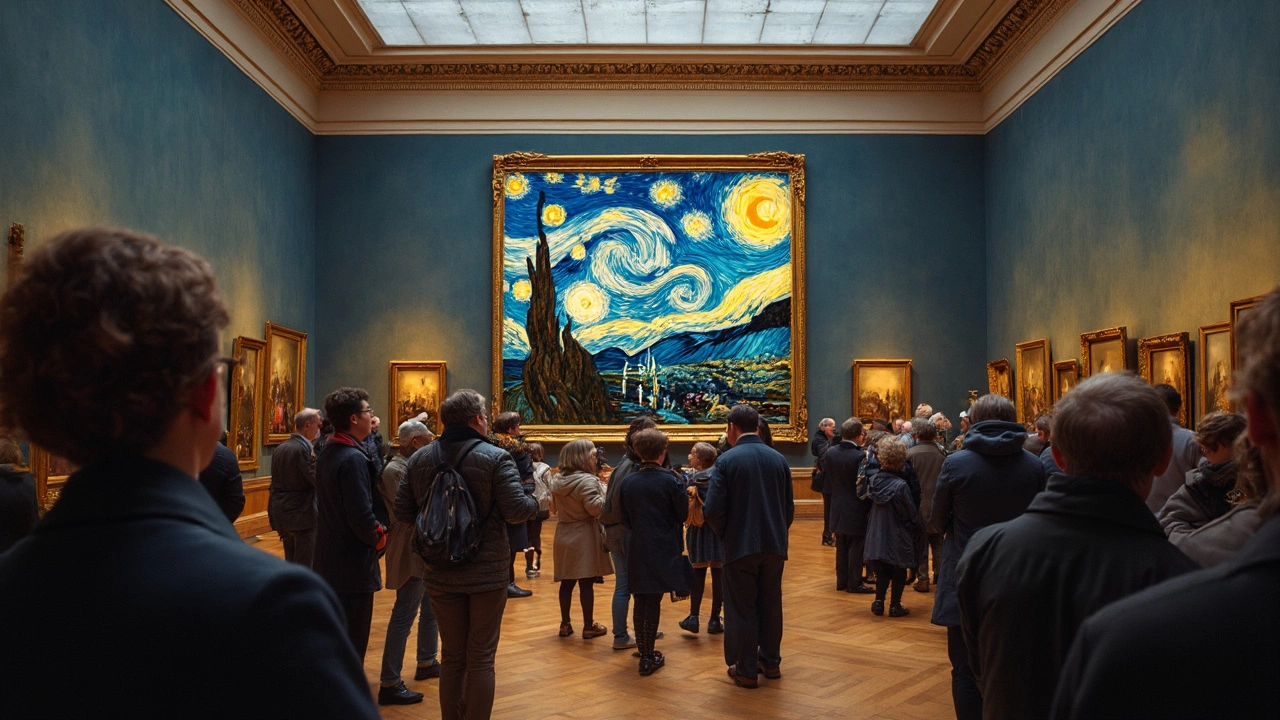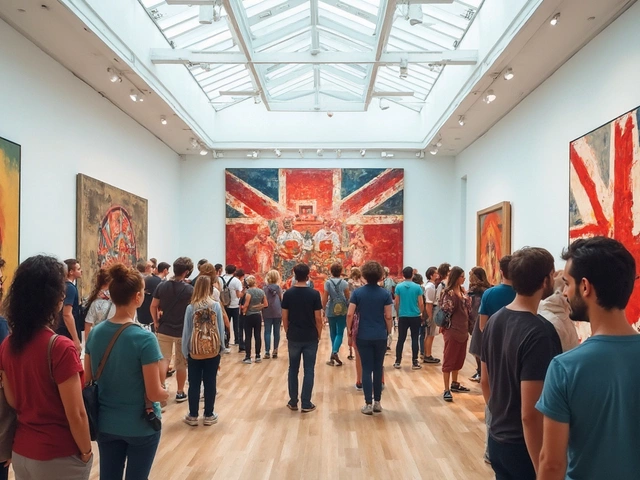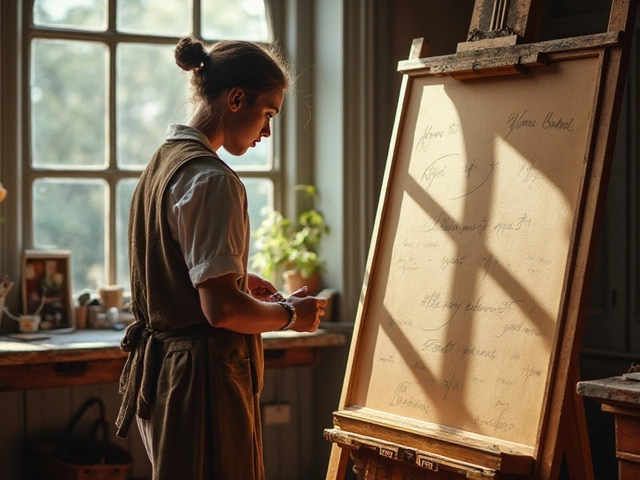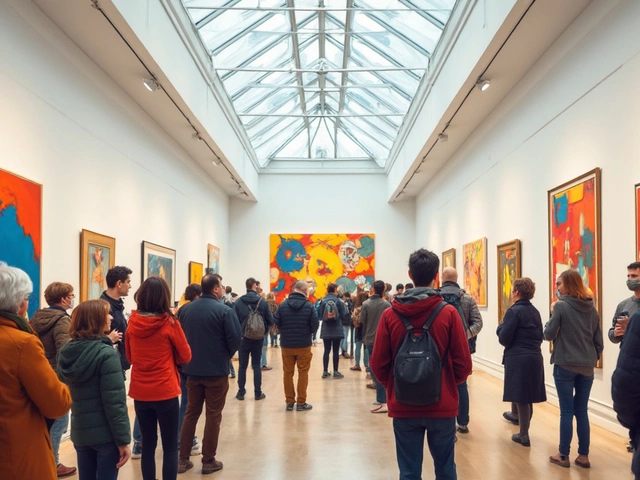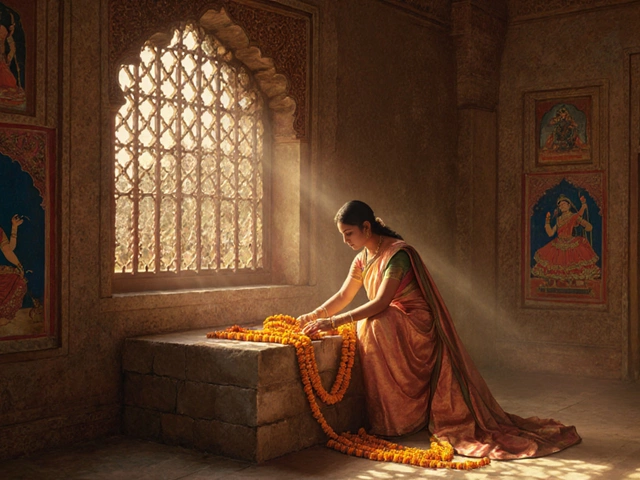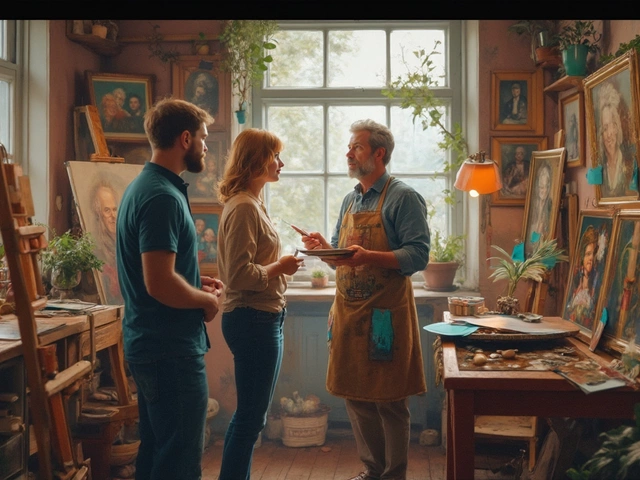People always want to know if the real Starry Night still exists—and where they can go see it. Spoiler: it does, and there’s a clear answer. You won’t find it tucked away in a secret collection or lost to history. This isn’t just another legend about a masterpiece gone missing. Curious about how museums keep something that old and fragile safe? There are a lot of myths floating around, but I’ll break down the facts.
If you’re thinking about making a trip to see it in person or you just want to know how places like the Museum of Modern Art keep this stuff from fading or falling apart, you’re in the right spot. Forget the rumors and mixed-up stories. Here, you’ll find out exactly where the original Starry Night lives and why it actually still looks amazing, even after more than 130 years.
- The Origins of Starry Night
- Where Is the Original Painting Now?
- How Has It Survived Over Time?
- Fake Starry Nights and Reproductions
- Visiting the Masterpiece: What to Expect
- What Makes Starry Night So Iconic?
The Origins of Starry Night
Van Gogh painted Starry Night in June 1889. He wasn’t in Paris or Amsterdam—he actually made the painting while staying in an asylum in Saint-Rémy-de-Provence, a small town in France. After a rough time with his mental health, he checked himself in, hoping for peace and recovery. But even from his room, he found inspiration.
The view? Not exactly what you see in the painting. The famous swirling sky and bold colors were more from van Gogh’s mind than from his window. He’d seen the olive trees and hills, sure, but he exaggerated and changed things. Sometimes, he painted at night with candles stuck in his hat to see. But for Starry Night, he did most of it during the day, from memory. It wasn’t a quick sketch either. He wrote to his brother Theo about the painting, worried people would think it was too unrealistic, but he went with his gut and finished it anyway.
| Fact | Details |
|---|---|
| Date painted | June 1889 |
| Location | Saint-Rémy-de-Provence, France |
| Medium | Oil on canvas |
| Canvas size | 73.7 cm × 92.1 cm (29 in × 36 1⁄4 in) |
| Time to complete | A few days (from sketches and memory) |
Starry Night isn’t van Gogh’s only night sky painting, but it’s the one everyone knows. He was obsessed with the night—he wrote that the night was “more colorful than the day.” There’s a church steeple from his Dutch roots, even though there wasn’t a church like that in the real French town. If you look closely at the painting, you’ll catch these mix-and-match details. He really made it into his own view of the world at that moment.
Starry Night wouldn’t mean much if it was just a copy of a real landscape. Because of van Gogh’s changes and bold style, the original Starry Night stands out as something totally different from typical landscape art of his time.
Where Is the Original Painting Now?
If you're looking for the actual, authentic original Starry Night, you won’t need a treasure map. The painting has a permanent home in New York City at the Museum of Modern Art (MoMA). Don’t listen to what you might’ve heard on TikTok or from your artsy friend—it’s not hidden in some millionaire’s basement or locked away in a vault in a small town in France.
MoMA picked up Starry Night back in 1941. Before that, it bounced around a few collectors. But ever since it landed in New York, it’s been a must-see. If you want to see the real deal, not a print or digital copy, you’ve gotta head to MoMA’s fifth-floor galleries. It rarely moves, and it’s almost always on display in the main collection.
Here’s a little table with quick facts about its location:
| Fact | Detail |
|---|---|
| Current Location | Museum of Modern Art (MoMA), New York |
| Acquired By MoMA | 1941 |
| Where in MoMA? | Floor 5, Gallery 502 |
| On Public View? | Yes, almost always |
| Security & Conservation | Regularly checked, climate-controlled |
MoMA’s got some seriously strict controls to keep Starry Night safe. The gallery is climate-controlled, and security is always close by. In fact, Starry Night has survived everything from wild crowds to the climate changes in New York, thanks to MoMA’s top-notch conservation team. You don’t need special tickets—any basic MoMA admission gets you in, but sometimes the room gets crowded fast. So if you want a good look, it’s smart to go when the museum first opens or late in the afternoon.
How Has It Survived Over Time?
It’s kind of wild how well the original Starry Night has held up, considering it was finished in 1889. The painting is actually oil on canvas, and van Gogh had a thing for using thick paint—he just piled it on. You’d think that stuff would crack and peel over the decades, but it hasn’t fallen apart. That’s because museums like the Museum of Modern Art (MoMA) have taken some serious steps to protect it since getting it in 1941.
Here’s what’s kept Starry Night safe and looking good for over a hundred years:
- Careful climate control: MoMA keeps Starry Night in a room where the temperature and humidity barely budge. Even just a little moisture or heat can mess with the canvas or colors.
- UV-blocking glass: Ever left something in a sunny room and watched it fade? That’s what UV light does to artwork. Starry Night is protected by glass that blocks almost all UV rays.
- Regular expert checkups: Conservators at MoMA look closely at the painting, checking for signs of damage or changes. They spot little problems before they become big ones.
- Very limited travel: It doesn’t leave New York. Shipping and changing climates are too risky. The last time it traveled for an exhibition outside MoMA was in 2019, and that was rare.
Want numbers? Check out these MoMA preservation stats (this is real info from how they care for masterpieces like this):
| Protection Detail | Starry Night Facts |
|---|---|
| Average room temperature | 21°C (about 70°F) |
| Humidity range | 45%–55% relative humidity |
| Light exposure | Below 50 lux (think dim indoor light) |
| Cleaning schedule | Thorough examination at least once a year |
This work behind the scenes is why the original Starry Night still pops with color and texture, even in 2025. If you see it up close, you’ll notice the thick, textured brushstrokes are just as bold as ever. It’s not locked away or lost—just watched over carefully and treated as the treasure it is.
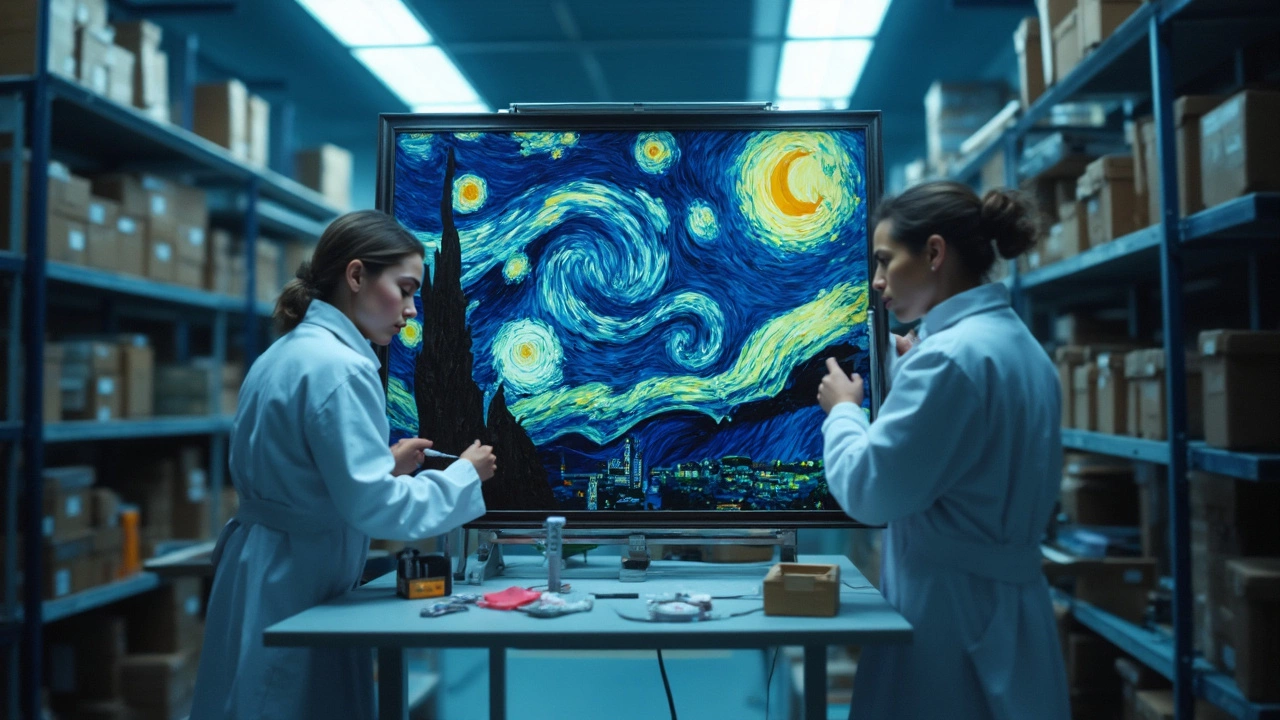
Fake Starry Nights and Reproductions
There's no denying the hype around van Gogh's Starry Night, but all that buzz comes with problems—tons of copies, fakes, and reproductions. If you see a Starry Night at a flea market or a random gallery, it’s not the real deal. The actual painting only exists at one place: the Museum of Modern Art (MoMA) in New York. Every other version out there, no matter how good, is just a copy.
Reproductions of this painting pop up everywhere. Think about it: dorm room posters, mousepads, jigsaw puzzles, coffee mugs, digital prints for less than $10 on Etsy. Even some professional artists hand-paint "replicas" that look almost identical to the original. Van Gogh’s brushstrokes have become so famous that people instantly know the image, but the real Starry Night never leaves the museum.
So, what about fakes? Forgers have tried for decades to pass off their own "van Goghs" to fool buyers. Art law expert Sharon Flescher once said,
"For every recognized van Gogh, there are easily dozens of fakes or disputed works. Starry Night, being so iconic, is especially targeted for knock-offs."
The market for these fakes is huge—even in 2007, French police broke up a fake art ring that focused on copying modern masters, including van Gogh. Some fakes have fooled buyers for six figures, but experts can usually spot differences in the paint, canvas, or signature. High-level scientific tests like X-ray fluorescence and pigment analysis make it way harder for fakes to slip through now.
Want some quick numbers? Check out how widespread the copies are:
| Type | Estimated Number Sold Annually |
|---|---|
| Licensed Posters | Over 500,000 |
| Online Art Prints | At least 250,000 |
| Handmade Replicas | 10,000+ |
| Unauthorized Merchandise | Thousands (unknown exact count) |
So here's what matters: if you want to experience the original Starry Night, you’ve got one option—visit MoMA. If someone tries to sell you a "real" one, they're either joking or running a scam. Enjoy the prints and merchandise, but remember, there’s only one true masterpiece, and it isn't for sale.
Visiting the Masterpiece: What to Expect
If you really want to see van Gogh’s original Starry Night, you need to head to New York City. The painting isn’t on tour or in somebody’s basement—it’s part of the permanent collection at the Museum of Modern Art (MoMA). MoMA has had it since 1941, and honestly, it’s one of their showpiece attractions. You’ll usually find it upstairs on the fifth floor with the other heavyweight modern art pieces.
The spot is no secret, so expect crowds. Even on weekdays, a bunch of people gather around for the “wow” moment. Here’s the good news though—MoMA is used to this. They keep the climate controlled, limit how many people crowd the painting, and keep things moving. Security is tight, but you’ll get a clear look. Taking photos is usually allowed (without flash), which is pretty cool for bragging rights.
Here’s some practical info to plan your trip:
- Location: MoMA, 11 West 53rd Street, Manhattan, New York City
- Floor: 5th floor (check interactive guides or ask staff—it doesn’t move far)
- Price: Adult tickets run $30, students $17, under 16s get in free
- Hours: Usually open 10:30 a.m.–5:30 p.m. (closed Tuesdays, but always check the website for latest updates)
For a quick look at the numbers:
| Fact | Detail |
|---|---|
| Annual Visitors to MoMA | ~2.2 million |
| Estimated Daily Visitors to Starry Night | Up to 5,000 on peak days |
| Starry Night Painting Size | 73.7 cm x 92.1 cm (29 in × 36 1⁄4 in) |
If you want a less crowded view, go early in the morning or during weekday afternoons (avoid public holidays if you can). While you can’t get close enough to touch it—the museum’s not taking any chances—the lighting is set up to show every brushstroke. Looking for a guide? MoMA offers audio tours that tell you the backstory while you stand in front of the real thing. You can also grab a print or magnet in the gift shop—seriously, there’s no shortage of Starry Night souvenirs.
Just remember, if you’re a serious art fan, take your time and stand back to catch the deep blues and swirling stars the way van Gogh meant you to. Tons of people rush in for a quick selfie, but it’s a whole different thing if you soak it in for a few extra minutes.
What Makes Starry Night So Iconic?
There’s a reason you see Starry Night just about everywhere—on shirts, mugs, school books, phone backgrounds. Let’s break down why this single painting grabs so much attention and keeps folks talking, no matter how many years go by.
First, the look of it is totally different from classic art before it. Most paintings at the time were all about realism, but van Gogh tossed that out the window. He used thick paint (the technique’s called impasto), big swirling brush strokes, and vivid blues and yellows that seem to move and pulse. That wild sky isn’t just a background—it’s the star of the show.
The story behind it is just as gripping. Vincent van Gogh painted Starry Night in June 1889 while living in an asylum in Saint-Rémy, France. He’d checked himself in after a rough patch. Despite struggling with his mental health, he produced this masterpiece by looking out his bedroom window. That mix of personal struggle and genius creativity makes the story hit even harder.
It’s not just about the looks or backstory. Starry Night keeps showing up in lists of the world’s most famous paintings. Here’s some hard data:
| Fact about Starry Night | Detail |
|---|---|
| Year Painted | 1889 |
| Painted By | Vincent van Gogh |
| Dimensions | 73.7 cm x 92.1 cm (29 x 36 1/4 in) |
| Current Location | Museum of Modern Art, New York City |
| Estimated Insurance Value | Over $100 million (but it’s unlikely to ever be sold) |
Besides all that, Starry Night was a game-changer for modern art. Van Gogh’s bold colors and unique style inspired a bunch of later artists, from Matisse to Pollock. Art students literally study this painting to learn about movement, color, and emotion on canvas.
If you check out visitor numbers at the Museum of Modern Art, Starry Night is the one artwork just about every visitor stops to see. It draws millions of visitors each year. Don’t expect a quiet moment alone with it—it’s usually surrounded by people snapping photos or just standing, staring, and soaking up those swirling stars.
- The swirling patterns became a symbol for mental health struggles and creative bursts.
- It’s been referenced in movies, music (like Don McLean’s “Vincent”), and even space science.
- Countless parodies and versions exist—Starry Night has truly gone viral, old-school style.
So, this painting really does have it all: a wild story, a unique look, real influence, and numbers to back up the hype. That mix is exactly why it’s so iconic.
